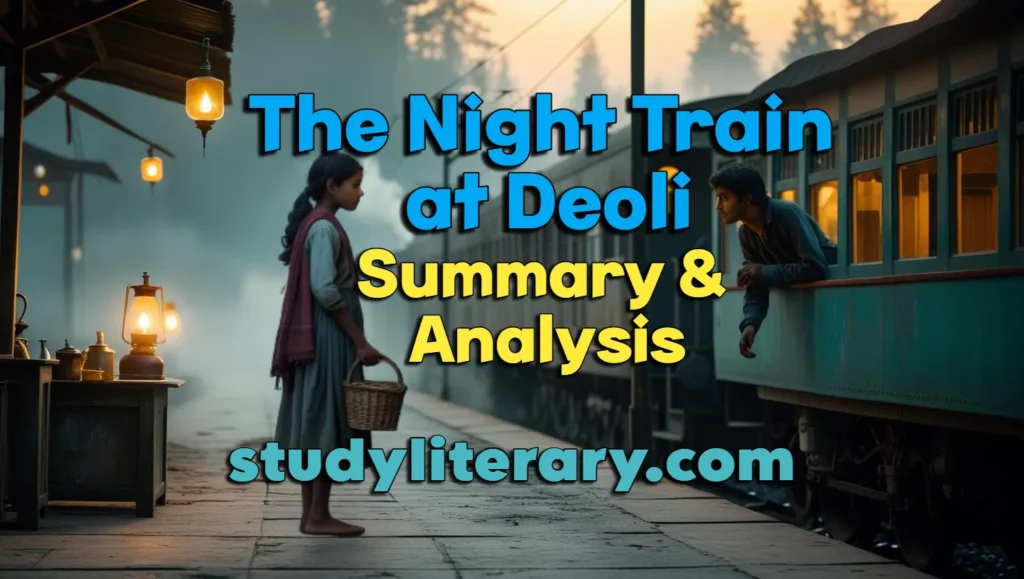
Table of Contents
ToggleThe Second Coming Summary in English
The world is falling into chaos.
A bird (the falcon) has flown so far it can’t hear the person who trained it — this means people have lost control of what they created.
Everything is falling apart, and there is no strong center or stability left.
Violence and disorder have spread everywhere.
Innocent and good things are being destroyed.
Good people are quiet and unsure, while bad people are full of energy and confidence.
The poet feels something big and scary is about to happen — maybe a sign or a powerful event.
He thinks of “The Second Coming,” a Christian idea where Christ returns.
But instead of Jesus, he sees a frightening image:
A huge creature with the body of a lion and the head of a human, with cold, lifeless eyes.
This monster walks slowly in the desert, surrounded by angry birds.
Then darkness comes again, but the poet realizes something deep:
For 2,000 years (since Christ was born), the world has been asleep.
But now, something terrifying has been awakened — not a peaceful savior, but a wild beast.
It is finally time for this beast to go to Bethlehem (the place where Jesus was born),
but it brings fear, not hope.
Meaning:
Yeats is saying that the world is changing in a scary way.
Instead of a new age of peace and love, something dark and violent may be coming.
He fears that the future may be led by something cruel and powerful, not by goodness or wisdom.
The Second Coming Summary in Hindi
दुनिया बिखर रही है।
एक बाज़ (फाल्कन) बहुत दूर उड़ गया है और अब अपने मालिक (जो उसे उड़ाना सिखाता है) की आवाज़ नहीं सुन पा रहा है — इसका मतलब है कि अब इंसान अपने बनाए हुए कामों पर नियंत्रण खो चुका है।
हर चीज़ टूट रही है, कोई संतुलन नहीं बचा।
अराजकता (अव्यवस्था और हिंसा) चारों तरफ फैल गई है।
मासूमियत और अच्छाई डूब गई हैं।
अच्छे लोग चुप और भ्रमित हैं, जबकि बुरे लोग बहुत जोश और ताकत में हैं।
शायर को लगता है कि कुछ बड़ा और डरावना होने वाला है — शायद कोई भविष्य की निशानी।
वो सोचता है कि “दूसरा आगमन” (Second Coming), यानी ईसा मसीह का फिर से आना, पास है।
लेकिन जैसे ही वह ऐसा सोचता है, उसे एक भयानक सपना जैसा दृश्य दिखता है:
एक विशाल जीव — जिसका शरीर शेर का है और चेहरा इंसान जैसा।
उसकी नज़रें ठंडी और निर्दयी हैं, जैसे तेज़ सूरज।
वो धीरे-धीरे रेगिस्तान में चल रहा है, और उसके चारों ओर गुस्से वाले पक्षी उड़ रहे हैं।
फिर अंधेरा छा जाता है। लेकिन अब शायर को एक बात समझ आती है:
पिछले 2000 सालों से दुनिया जैसे गहरी नींद में थी।
अब एक झूले की हलचल से ये नींद डरावने सपने में बदल गई है।
अब कोई भयंकर दरिंदा, जिसका समय आ गया है, बेतलेहम (Bethlehem) की ओर बढ़ रहा है —
लेकिन वह शांति या प्रेम नहीं, बल्कि डर और तबाही लेकर आ रहा है।
मतलब:
Yeats कहना चाहते हैं कि दुनिया एक डरावने बदलाव की ओर जा रही है।
यह नया समय किसी मसीहा का नहीं, बल्कि एक खतरनाक और निर्दयी शक्ति का हो सकता है।
यह कविता बताती है कि जब अच्छाई चुप हो जाती है और बुराई ताक़तवर हो जाती है,
तो दुनिया संकट में आ जाती है।
The Second Coming Summary in Urdu
دنیا بربادی کی طرف جا رہی ہے۔
ایک باز (پرندہ) اتنا دُور اُڑ چکا ہے کہ اب اپنے مالک کی آواز نہیں سن سکتا — مطلب یہ کہ انسان نے جو چیزیں بنائیں، اب وہ اُن کے قابو سے باہر ہو گئی ہیں۔
ہر چیز ٹوٹ پھوٹ کا شکار ہے، اور اب دنیا میں کوئی مضبوط مرکز یا سہارانہیں بچا۔
فساد اور بے ترتیبی ہر طرف پھیل چکی ہے۔
معصومیت اور نیکی کو دبا دیا گیا ہے۔
اچھے لوگ خاموش اور کمزور ہیں، جبکہ برے لوگ زور شور اور جوش سے بھرے ہوئے ہیں۔
شاعر کو لگتا ہے کہ کوئی بہت بڑا اور خوفناک واقعہ ہونے والا ہے — شاید کوئی نشانی یا نیا دور۔
کے بارے میں سوچتا ہے “Second Coming” (حضرت عیسیٰؑ کا دوبارہ آنا) وہ
لیکن حضرت عیسیٰؑ کی جگہ، اُسے ایک ڈراؤنا منظر نظر آتا ہے:
ایک عجیب مخلوق جس کا جسم شیر جیسا ہے، اور چہرہ انسان جیسا۔
اس کی آنکھیں سرد اور بے رحم ہیں، جیسے سورج کی تپش۔
یہ مخلوق آہستہ آہستہ صحرا میں چل رہی ہے، اور اس کے ارد گرد غصے والے پرندے چکر لگا رہے ہیں۔
پھر اندھیرا چھا جاتا ہے، لیکن شاعر کو ایک اہم بات سمجھ آتی ہے:
دو ہزار سال (یعنی حضرت عیسیٰؑ کے زمانے سے اب تک) دنیا جیسے گہری نیند میں تھی۔
اب یہ نیند ایک خوفناک خواب میں بدل گئی ہے — ایک جھولے کی حرکت سے سب کچھ بیدار ہو گیا ہے۔
اب کوئی وحشی درندہ، جس کا وقت آ گیا ہے، بیت اللحم (Bethlehem) کی طرف جا رہا ہے —
لیکن وہ امن یا امید نہیں، بلکہ خوف لے کر آ رہا ہے۔
:مطلب
کہنا چاہتے ہیں کہ دنیا ایک خوفناک تبدیلی کی طرف بڑھ رہی ہے۔ Yeats
ایک نیا دور آنے والا ہے، لیکن یہ کوئی امن کا دور نہیں ہوگا —
بلکہ ایسا وقت ہو گا جس میں ظلم، اندھیرا اور وحشی پن حکومت کرے گا۔
Critical Analysis of The Second Coming
Introduction:
“The Second Coming” is a powerful and famous poem written in 1919 by Irish poet W.B. Yeats.
It was written after World War I, a time when the world was full of violence, confusion, and fear.
In this poem, Yeats shares his worry about the future of the world. He believes that a new, dark, and dangerous age is coming — not a time of peace, but of destruction.
Themes
1. Main Theme – The World is in Chaos
The poem begins with the picture of a world that is falling apart.
Yeats uses the image of a falcon (bird) flying in circles and getting so far away that it cannot hear its master (falconer).
This shows that humans have lost control of their own creations — like science, war, or politics.
The line “Things fall apart; the centre cannot hold” means that there is no balance or control left.
The world is in deep trouble, with violence and confusion spreading everywhere.
2. Good vs. Evil
Yeats says the “best” people have lost confidence, and they don’t speak or act.
Meanwhile, the “worst” people are very active and full of energy — but in a dangerous way.
This suggests a world where bad people lead, and good people stay silent, which makes the situation worse.
The poet is deeply worried about the future of humanity.
3. The Second Coming – But Not of Jesus
The poet wonders if a new age is coming.
He talks about “The Second Coming,” which in Christianity means Jesus will come again to bring peace and justice.
But what Yeats sees is not Jesus — it is something strange and scary.
4. The Strange Beast
Yeats describes a giant creature — body of a lion, head of a man, and eyes cold like the sun.
This beast is slowly walking in the desert, and angry birds fly around it.
It feels like this monster is about to take over the world.
The “Spiritus Mundi” (Latin for “world spirit”) shows that this image is not from his imagination alone, but from the shared fear and memory of all people.
The poet uses this image to warn us — that something dark and evil is rising in place of hope.
5. History and Time
Yeats says that for 2,000 years, since the birth of Jesus, the world has been in a kind of deep sleep.
But now, the rocking of a baby’s cradle (maybe symbolizing the modern world or war) has woken up a nightmare.
Instead of a kind savior being born again, a “rough beast” is coming to Bethlehem, the place where Jesus was born — but it brings fear, not love.
6. Symbolism and Message
Falcon and Falconer = Losing control
Blood-dimmed tide = Violence spreading
Best vs. Worst = Good people are quiet; bad people are powerful
Second Coming = A big change coming, but it’s dark, not hopeful
Rough Beast = A new, dangerous force replacing old beliefs
Final Thoughts
Yeats wrote this poem after World War I, when the world felt broken.
He feared that a new kind of evil leadership or belief system could rise.
The poem is not just about religion, but about history, society, and human nature.
Yeats warns us:
When good people do nothing, and bad people rise,
the world may not be saved by light — but taken over by darkness.
Style and Language:
The poem uses powerful images (like the falcon, the beast, the desert) to show danger and fear.
Yeats writes in free verse (no fixed rhyme or rhythm), which gives the poem a natural, flowing feel.
The language is symbolic — it doesn’t always say things directly, but uses symbols to express deep thoughts.
The tone is dark, serious, and mysterious.
Why This Poem is Important:
It reflects the fear of modern times — war, political instability, and loss of faith.
It’s still relevant today, because many people feel the world is again going through confusion and crisis.
It is a brilliant example of modern poetry that mixes history, religion, and imagination.
Share
- Facebook
- Twitter
- Linkedin
- Whatsapp
- Pinterest
- Telegram


